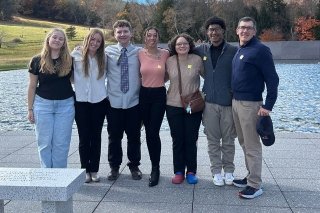Anthropologist’s book focuses on Delaware Water Gap National Recreation Area
University-wide
Posted

BLOOMSBURG — Was the government justified in creating the Delaware Water Gap National Recreational Area? That is the question that David Fazzino, a cultural anthropologist and associate professor and chairperson of the Department of Anthropology, Criminal Justice, and Sociology, explores in a new book.
Fazzino’s book, Historic Takings in Delaware Water Gap National Recreation Area: Recreation and Remains, highlights the consequences and costs of government interventions designed to make the world a better place through development projects. He does so by examining the ill-fated federal government project of the Tocks Island Dam by highlighting the experiences of those who lived with, and through the government takings, the failure of the Tocks Island project, and the creation of the Delaware Water Gap National Recreation Area.
To research the book, Fazzino interviewed nearly two dozen people and drew upon two dozen interviews of people that were kept in the Park Service archives. The project brought the anthropologist back to the area where he’d grown up as a teenager.
“It was great for me growing up. My parents’ house was a quarter mile from park entrance,” said Fazzino. “I would go there and a lot of times there was no one around.”
Returning to Pennsylvania after studying and working in locations ranging from Florida to Arizona to Alaska, Fazzino’s view of the park began to change.
“The dam was the reason that the federal government bought land on both the New Jersey and Pennsylvania sides of the Delaware River. The federal government bought out residents in the 1960s and 70s through eminent domain. The government hired assessors to look for the lowest comparable prices possible. Offers from the government didn’t include structures and crops, such as orchards, berry, and flower plantings,” said Fazzino. One particularly poignant example was an older woman who lamented the loss of her rose bushes.
“To add insult to injury. The government couldn’t bulldoze many of the properties right away and people from outside the valley started to move in,” Fazzino added. “The squatters told the government they would only move if the government built the dam. But the government plan was without enough money, foresight, or staff. The government never had the geology right. It was very messy and there were and still are a lot of bitter feelings.”
The land that had been acquired became Delaware Water Gap National Recreation Area, among the busiest National Park Service locations with millions of annual visitors.
“There’s a human element to this government action,” Fazzino said. “That’s the thing about culture. It permeates the way we think about the world. It means something to take possession of a space and move in and something else when someone else takes possession and moves in.”
“The families affected were in some instances the sons and daughters of the American Revolution,” said Fazzino, who notes that structures, some lived in over generations, dating as far back as the 1700s, continue to crumble each year. “The Park Service is fighting a losing battle. The emphasis of the park is the river rather than the human history.”
Fazzino’s approach to the book, is partly autobiographical. “I realize the privilege we have to be in these spaces. The book brings stories together and can be of interest to people in environmental studies, local history, anthropology, and legal studies.”
Published through Lexington Books, a portion of the book is available for free through Google Books and is available electronically and for the Kindle.



